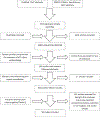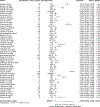"What's my risk of sustaining an ACL injury while playing sports?" A systematic review with meta-analysis
- PMID: 29514822
- PMCID: PMC6561829
- DOI: 10.1136/bjsports-2016-096274
"What's my risk of sustaining an ACL injury while playing sports?" A systematic review with meta-analysis
Abstract
Objective: To estimate the incidence proportion (IP) and incidence rate (IR) for ACL injury in athletes.
Design: Systematic review with meta-analysis DATA SOURCES: The PubMed, CINAHL and SPORTDiscus electronic databases were searched from inception to 20 January 2017.
Eligibility criteria for selecting studies: Studies were included if they reported total number of participants/population by sex, total number of ACL injuries by sex and total person-time by sex.
Results: Fifty-eight studies were included. The IP and IR of ACL injury in female athletes were 3.5% (1 out of every 29 athletes) and 1.5/10 000 athlete-exposures over a period of 1 season-25 years. The IP and IR of ACL injury in male athletes were 2.0% (1 out of every 50 athletes) and 0.9/10 000 athlete-exposures over a period of 1-25 years. Female athletes had a higher relative risk (RR) for ACL injury compared with males (RR=1.5; 95% CI 1.2 to 1.9; P<0.01) and a higher incidence rate ratio (IRR) of ACL injury compared with males over 1 season-25 years (IRR=1.7; 95% CI 1.4 to 2.2; P<0.010). When accounting for participation level, the disparity in the IR between female and male athletes was highest for amateur athletes compared with intermediate and elite athletes (IRR=2.1; 95% CI 1.3 to 3.4; P<0.01; I²=82%). Amateur female athletes remained at higher risk of ACL injury than did with amateur male athletes. In studies where follow-up length was <1 year, female athletes had a higher IR of ACL injury than did to males (IRR=1.7; 95% CI 1.3 to 2.2; P<0.01). Where follow-up was 1 year and beyond, there was no sex difference in the IR of ACL injury (IRR=2.1; 95% CI 0.9 to 4.8; P=0.06; I²=65%).
Summary/conclusions: One in 29 female athletes and 1 in 50 male athletes ruptured their ACL in a window that spanned from 1season to 25 years. The IR of ACL injury among female athletes in a season was 1.7 times higher than the IR of ACL injury among male athletes and the IP of ACL injury among female athletes was 1.5 times higher than the IP of ACL injury among male athletes. The reported sex disparity in ACL injury rates is independent of participation level and length of follow-up.
Keywords: ACL; athlete; epidemiology; knee.
© Article author(s) (or their employer(s) unless otherwise stated in the text of the article) 2019. All rights reserved. No commercial use is permitted unless otherwise expressly granted.
Conflict of interest statement
Competing interests: None declared.
Figures











References
-
- Agel J, Arendt EA, Bershadsky B. Anterior cruciate ligament injury in national collegiate athletic association basketball and soccer: a 13-year review. Am J Sports Med 2005;33:524–31. - PubMed
-
- Hewett TE, Myer GD, Ford KR, et al. Biomechanical measures of neuromuscular control and valgus loading of the knee predict anterior cruciate ligament injury risk in female athletes: a prospective study. Am J Sports Med 2005;33:492–501. - PubMed
-
- Hewett TE, Myer GD, Ford KR. Anterior cruciate ligament injuries in female athletes: Part 1, mechanisms and risk factors. Am J Sports Med 2006;34:299–311. - PubMed
-
- Alentorn-Geli E, Myer GD, Silvers HJ, et al. Prevention of non-contact anterior cruciate ligament injuries in soccer players. Part 1: Mechanisms of injury and underlying risk factors. Knee Surg Sports Traumatol Arthrosc 2009;17:705–29. - PubMed
Publication types
MeSH terms
Grants and funding
LinkOut - more resources
Full Text Sources
Other Literature Sources
Medical
Molecular Biology Databases
